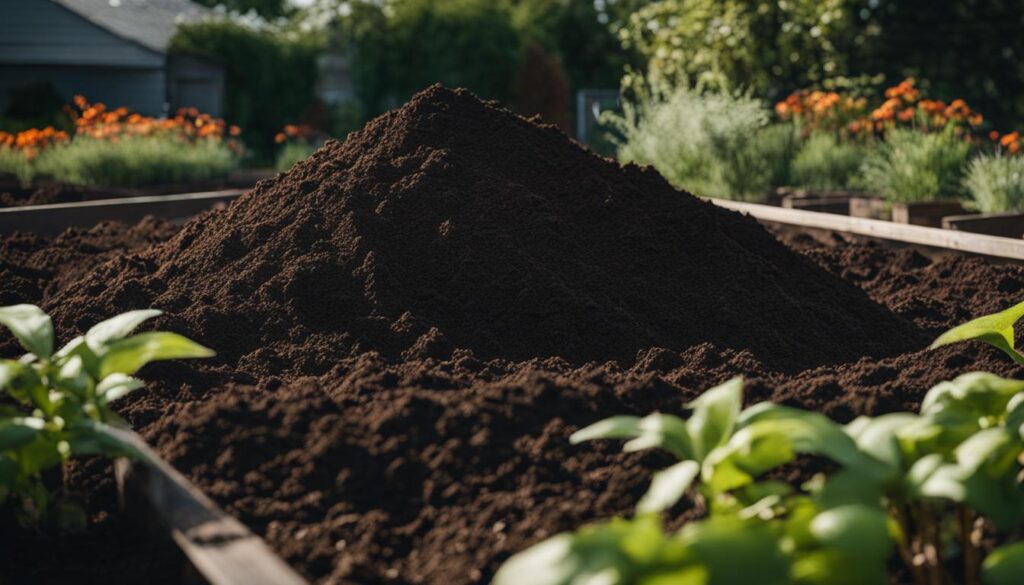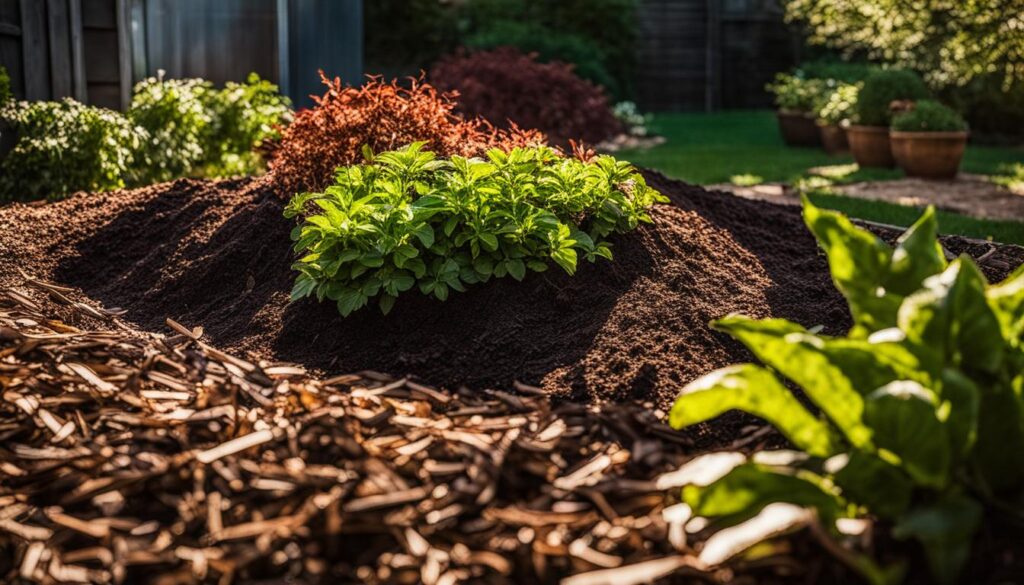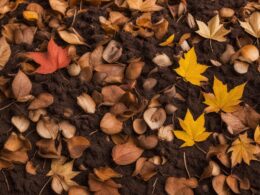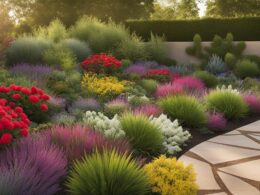Are you looking to save water, enhance the beauty of your landscape, and reduce your utility bills? Look no further than xeriscaping techniques for water conservation. Xeriscaping is a practical and sustainable approach to landscaping that focuses on using water efficiently in dry conditions. By implementing these techniques, you can not only save water but also create a visually appealing outdoor space that thrives even in limited water availability.
Key Takeaways:
- Xeriscaping is a water-wise and budget-friendly approach to landscaping.
- It focuses on using water efficiently in the landscape, reducing water bills and ensuring plant survival.
- Xeriscaping involves principles such as soil amendment, mulching, plant selection, and turfgrass reduction.
- By grouping plants based on their water needs and implementing proper irrigation, water can be used more efficiently.
- Reducing areas of turfgrass and adopting water conservation tips for your lawn also contribute to water savings.
What Does Xeriscaping Mean?
Xeriscaping is a term derived from the Greek root word “xeros,” meaning dry. It refers to the practice of using water efficiently in the landscape, especially in dry conditions. Xeriscaping involves an integrated approach to conserving water and creating a landscape that is adaptable to limited water availability.
When you engage in xeriscaping, you are implementing water-efficient landscaping techniques that are specifically designed for dry conditions. By understanding the meaning behind xeriscaping, you can appreciate its importance in water conservation efforts.
“Xeriscaping is a water-wise and budget-friendly approach to landscaping that focuses on using water efficiently in the landscape.”
With xeriscaping, you are not just limiting your water usage, but you are also creating a landscape that can thrive even in areas with minimal rainfall. By incorporating principles such as soil amendment, mulching, suitable plant selection, and proper water grouping, xeriscaping allows you to maintain landscape beauty while minimizing water consumption.
As you explore the world of xeriscaping, it is essential to understand its meaning and the benefits it can bring to your outdoor spaces. By adopting water-efficient landscaping practices, you can create a vibrant and sustainable landscape that can withstand dry conditions.
Table: Benefits of Xeriscaping
| Benefits | Description |
|---|---|
| Water Conservation | Xeriscaping significantly reduces water usage by using water-efficient practices, helping conserve this precious resource. |
| Financial Savings | By minimizing water consumption, xeriscaping can lead to lower water bills. |
| Environmental Sustainability | Xeriscaping promotes environmental consciousness by reducing the strain on local water supplies and minimizing the need for chemical fertilizers and pesticides. |
| Aesthetic Appeal | Even with limited water availability, xeriscaping allows you to create a beautiful and visually appealing landscape using drought-tolerant plants and creative design elements. |
| Low Maintenance | The use of native and adapted plants in xeriscaping can reduce the need for constant watering and maintenance, making it a practical choice for busy homeowners. |
Principles of Xeriscaping
Implementing the principles of xeriscaping is crucial to creating a water-efficient and sustainable landscape. By following these principles, you can conserve water, reduce maintenance, and still enjoy a beautiful outdoor space. Let’s explore the key principles of xeriscaping:
1. Soil Amendment
Amending the soil is the foundation of a successful xeriscape. By improving soil quality, you can enhance water retention and drainage, ensuring that plants receive adequate moisture without excess water pooling on the surface. To amend the soil, add organic matter such as compost or well-rotted manure, which will improve both water-holding capacity and nutrient availability.
2. Mulching
Mulching is an effective technique to conserve soil moisture and suppress weed growth. Apply a layer of mulch around plants to reduce evaporation, regulate soil temperature, and inhibit weed competition. Organic mulches like wood chips or straw are excellent options that gradually break down, enriching the soil as they decompose.
3. Selecting Suitable Plants
Choosing plants that are well-suited to your climate and local conditions is vital for xeriscaping. Opt for drought-tolerant plants that can thrive with minimal water requirements. Native plants are particularly adapted to the local environment and often have deep root systems that efficiently access water reserves. By selecting suitable plants, you can reduce the need for excessive irrigation and save water.
| Water Needs | Examples |
|---|---|
| Low | Lavender, Agave, Yucca |
| Moderate | Salvia, Penstemon, California Poppy |
| High | Hydrangea, Impatiens, Ferns |
4. Turfgrass Reduction
Lawn areas are notorious water guzzlers in traditional landscapes. Consider reducing the amount of turfgrass in your yard and replacing it with alternative ground covers or hardscape features. By minimizing turfgrass, you can significantly decrease water consumption while enhancing the overall aesthetic appeal of your landscape.
By incorporating these xeriscaping principles into your landscape design, you can create a beautiful, water-efficient, and environmentally-friendly outdoor space. Embrace xeriscaping techniques, conserve water, and enjoy a thriving garden that will be the envy of your neighborhood.
Amend the Soil
Amending the soil is a crucial step in xeriscaping. By improving the soil’s ability to retain water while still being well-draining, you can create the optimal growing conditions for your plants.
To amend the soil, start by adding compost and organic matter. These materials help to increase the soil’s water retention capacity and provide essential nutrients for plant growth. Compost also improves soil structure, allowing for better penetration of water and roots.
When amending the soil, it’s important to assess its current composition. If you have heavy clay soil, adding sand or perlite can help improve its drainage. For sandy soil, incorporating organic matter can enhance its water-holding capacity.
Benefits of Soil Amendment for Xeriscaping
- Improved water retention
- Enhanced drainage
- Increased nutrient availability
- Promoted healthy root development
By amending the soil, you create a foundation for a thriving xeriscape. The enhanced water retention and drainage ensure that your plants have access to the water they need while preventing excess water from causing root rot or other issues. With well-amended soil, you can create a sustainable and water-efficient landscape that thrives even in dry conditions.
| Soil Amendment Materials | Advantages |
|---|---|
| Compost |
|
| Sand or Perlite |
|
| Peat Moss |
|
“Amending the soil is like laying a solid foundation for your xeriscape. A well-amended soil not only improves water retention and drainage but also provides essential nutrients for plant growth. It’s the key to creating a thriving and water-efficient landscape.” – Xeriscape Expert
Remember to thoroughly mix the amendments into the existing soil and ensure even distribution. Regularly check the moisture level of the soil to prevent overwatering or underwatering. With well-amended soil, your xeriscaping efforts will be more successful, leading to a beautiful and sustainable landscape.
Mulch Your Plants
Mulching is a crucial practice in xeriscaping that helps conserve water and promote healthy plant growth. By applying a layer of mulch to the soil surface, you can greatly reduce moisture evaporation and improve moisture retention. This is especially beneficial in dry conditions where water availability may be limited.
When choosing mulching materials, there are several options to consider. Organic mulches, such as wood chips or pine straw, offer numerous benefits. They break down over time, enriching the soil with nutrients and improving its structure. Inorganic mulches, like plastic, have the advantage of long-lasting durability and weed suppression. Select the mulch that best suits your landscape needs and preferences.
To effectively mulch your plants, apply a layer of mulch that is at least 3 to 4 inches thick. This will help to suppress weeds, regulate soil temperature, and prevent moisture loss. Be mindful not to apply mulch too close to the plant stems, as this can promote fungal diseases. Leave a small gap around the base of the plants to allow for air circulation.
By mulching your plants, you can create a more resilient and water-efficient landscape. The layer of mulch acts as a protective barrier, reducing the need for frequent watering and saving water in the process. Embrace the benefits of mulching in your xeriscaping journey and enjoy a thriving, sustainable garden.
Select Suitable Plants
When it comes to xeriscaping, choosing the right plants is crucial for the success of your water-wise landscape. Opting for suitable plants that are drought-tolerant can significantly reduce your water consumption while still maintaining a beautiful and thriving garden.
Drought-tolerant plants are those that are adapted to arid conditions and can survive with minimal watering. These plants have evolved to store water in their leaves, stems, or roots, allowing them to endure dry spells without suffering. By incorporating drought-tolerant plants into your xeriscape, you can minimize the need for excessive irrigation and conserve water.
“Selecting native plants is key to xeriscaping success. Natives are naturally adapted to the local climate, soil, and rainfall patterns, making them well-suited for xeriscapes. Their survivability rate is higher, as they have evolved to endure the specific challenges of the region.”
In addition to drought-tolerant plants, native plants are also highly recommended for xeriscaping. Native plants are naturally adapted to the local climate, soil, and rainfall patterns, making them well-suited for xeriscapes. Their survivability rate is higher, as they have evolved to endure the specific challenges of the region. By incorporating native plants into your xeriscape, you can create a low-maintenance and water-efficient landscape that thrives in harmony with the surrounding environment.
Table: Recommended Drought-Tolerant and Native Plants for Xeriscaping
| Plant Name | Water Needs | Sun Exposure | Special Features |
|---|---|---|---|
| Agave americana | Low | Full sun | Drought-resistant, architectural form |
| Yucca filamentosa | Low | Full sun | Ornamental spiky foliage, desert adaptation |
| Lavandula angustifolia | Low | Full sun | Fragrant flowers, drought-tolerant herb |
| Penstemon eatonii | Low to moderate | Full sun to partial shade | Attracts hummingbirds, wildflower-like blooms |
| Echinacea purpurea | Low to moderate | Full sun to light shade | Butterfly-attracting, long-lasting blooms |
By selecting suitable plants like these, you can create a stunning xeriscape that not only conserves water but also enhances the beauty of your outdoor space. Remember to consider the specific water needs, sun exposure, and special features of each plant to ensure compatibility and long-term success in your xeriscape.
Group Plants According to Water Needs
In xeriscaping, grouping plants based on their water needs is an effective strategy to optimize irrigation and conserve water. By organizing plants into zones with similar water requirements, you can ensure that each plant receives the appropriate amount of water without wasting it on plants with lower water needs.
Benefits of Grouping Plants According to Water Needs
When plants with similar water requirements are grouped together, you can adopt a targeted approach to irrigation. Instead of watering the entire landscape uniformly, you can focus on specific zones, delivering water directly to the plants that need it the most. This not only reduces water waste but also improves the health and vitality of your plants.
By grouping plants according to their water needs, you can achieve irrigation efficiency and promote the long-term sustainability of your landscape.
How to Group Plants According to Water Needs
To effectively group plants based on their water needs, consider the following steps:
- Analyze the Water Requirements: Assess the water needs of each plant in your landscape. Consider factors such as sun exposure, soil type, and growth stage.
- Create Water Zones: Divide your landscape into zones based on the water requirements of the plants. For example, you may have a high-water zone for thirsty plants and a low-water zone for drought-tolerant varieties.
- Plan Irrigation System: Install an irrigation system that allows you to separately water each zone. This can include drip irrigation, soaker hoses, or separate sprinkler zones.
- Adjust Irrigation Schedule: Program your irrigation system to deliver the appropriate amount of water to each zone. This may involve adjusting the frequency and duration of watering based on the specific needs of the plants in each zone.
By implementing proper grouping techniques, you can efficiently manage water resources and promote the overall health and beauty of your landscape.
| Zone | Water Requirements |
|---|---|
| High-Water Zone | Thirsty plants that require regular watering |
| Moderate-Water Zone | Plants with average water needs |
| Low-Water Zone | Drought-tolerant plants that require minimal watering |
Reduce Areas of Turfgrass in Your Yard
To further enhance water conservation efforts in your xeriscaping journey, it is crucial to consider reducing the areas covered by turfgrass in your yard. Lawns are notorious water-guzzlers, especially when it comes to irrigation. By converting some of these grassy areas into flowerbeds or mulched islands, you can not only conserve water but also create a visually appealing and sustainable landscape.
Turfgrass reduction is a key principle of xeriscaping that can significantly decrease water consumption. While lawns do provide a lush and inviting look, they require frequent watering to maintain their vibrant appearance. By replacing portions of your lawn with native or drought-tolerant plants, you can create a more water-efficient and environmentally friendly outdoor space.
“Lawns are the biggest water consumers, especially if irrigated.”
As you embark on this journey, consider the specific areas of your yard that could benefit from turfgrass reduction. Identify sections that receive excessive irrigation and evaluate their potential for conversion. Transforming these areas into flowerbeds or installing mulched islands can not only reduce water usage but also enhance the overall aesthetics of your landscape.
| Benefits of Turfgrass Reduction | Water Conservation | Visual Appeal | Low Maintenance |
|---|---|---|---|
| Reduces water consumption | Creates a vibrant and diverse landscape | Requires less mowing and maintenance | |
| Minimizes runoff and water waste | Offers opportunities for colorful flowers and plants | Saves time and effort on lawn care | |
| Preserves water resources for other uses | Attracts beneficial insects and pollinators | Promotes a more sustainable outdoor space |
By reducing the areas covered by turfgrass and incorporating water-efficient alternatives, you can make a significant impact on your water conservation efforts. Not only will you be contributing to the preservation of water resources, but you will also be creating a stunning and environmentally conscious landscape that reflects your commitment to sustainability.
Water Conservation Tips for Your Lawn
Efficient lawn irrigation is essential for water conservation. By implementing a few simple practices, you can reduce water usage while maintaining a lush and healthy lawn. Follow these water conservation tips to make the most out of your lawn irrigation:
1. Time it Right
When it comes to watering your lawn, timing is everything. Watering in the early morning, before the heat of the day sets in, is the most effective. This allows the water to penetrate the soil and be absorbed by the grass roots without excessive evaporation. Watering during the cooler hours also prevents the growth of fungus and disease on damp grass.
2. Avoid Overwatering
Many homeowners tend to overwater their lawns, which not only wastes water but also encourages shallow root growth. Instead of watering for long periods, aim for deep, infrequent watering sessions. This promotes deep root growth and makes your lawn more resilient to drought conditions. A simple trick to determine if your lawn needs watering is to walk on it – if the grass springs back, it’s well-hydrated, but if it stays flat, it’s time to water.
3. Install Moisture-Sensing Devices
Moisture-sensing devices, such as rain sensors or soil moisture meters, can help optimize your lawn irrigation system. These devices detect when the soil is already saturated and prevent unnecessary watering. By only watering when needed, you can conserve water and prevent runoff.
Remember, a healthy lawn doesn’t require excessive watering. By following these water conservation tips, you can maintain a beautiful lawn while reducing your environmental impact and water bills.
Use a Rain Barrel System
Another effective method for water conservation in xeriscaping is the use of a rain barrel system. This simple and eco-friendly solution allows you to capture rainwater runoff from your roof and store it for later use in your landscape.
By incorporating a rain barrel system into your xeriscaping design, you can reduce your reliance on municipal water sources and take advantage of a free and abundant resource. The captured rainwater can be used to water your plants during dry spells, reducing the need for irrigation and saving precious water.
Installing a rain barrel system is relatively easy and cost-effective. There are numerous designs and sizes available to suit your needs. Simply place the rain barrel under a downspout and direct the runoff into it. The collected water can be accessed through a spigot or hose attachment when needed.
Benefits of a Rain Barrel System
Using a rain barrel system offers several significant benefits for xeriscaping and water conservation:
- Environmental Impact: By reducing your reliance on municipal water sources, you are helping to conserve this valuable resource and reduce the strain on local water supplies.
- Cost Savings: Utilizing rainwater from your rain barrel system can lead to substantial savings on your water bill, especially during the dry months when irrigation is necessary.
- Plant Health: Rainwater is naturally soft and free from the chemicals often found in tap water. Using rainwater for irrigation can promote healthier growth and improve the overall health of your plants.
Overall, incorporating a rain barrel system into your xeriscaping design is an effective way to conserve water, reduce your environmental impact, and save money. It is a simple and practical solution that aligns perfectly with the principles of xeriscaping.
Do Americans Really Care About Xeriscaping?
When it comes to adopting xeriscaping techniques for water conservation, are Americans truly on board? Recent research suggests that there is a growing awareness and interest in xeriscaping, with a significant number of individuals incorporating these practices into their homes.
A survey conducted across the United States revealed that 10% of respondents have already embraced xeriscaping as a means of conserving water. The Western Region of the country showed the highest adoption rate, indicating that people in drier areas are more inclined to prioritize water conservation in their landscaping efforts.
Concerns about water scarcity and rising utility bills are prominent factors driving the adoption of xeriscaping. As individuals become more conscious of the environmental impact of water usage, they are actively seeking ways to reduce their water consumption. Xeriscaping allows homeowners to maintain a visually appealing landscape while significantly lowering their water usage and related costs.
Table: Xeriscaping Adoption by Region
| Region | Percentage of Xeriscaping Adoption |
|---|---|
| Western | 15% |
| Southwest | 12% |
| Midwest | 7% |
| Northeast | 5% |
| Southeast | 3% |
This regional variation in xeriscaping adoption can be attributed to varying climates and water availability throughout the United States. In areas where water is scarcer, individuals are more likely to embrace water-wise landscaping practices such as xeriscaping to ensure the sustainability of their landscapes.
As the importance of water conservation grows, it is expected that more Americans will adopt xeriscaping techniques in the future. With its potential to significantly reduce water usage and its positive impact on the environment, xeriscaping is an increasingly popular choice for individuals who prioritize water conservation and want to create beautiful and sustainable landscapes.
Conclusion
In conclusion, xeriscaping techniques offer significant benefits in terms of water savings and environmental consciousness. By implementing principles such as soil amendment, mulching, plant selection, proper irrigation, and reducing turfgrass areas, you can reduce your water usage by up to 75%. This not only helps conserve water resources but also saves you money on utility bills.
Xeriscaping is a sustainable landscaping approach that aligns with your environmental consciousness. By adopting water-wise practices, you can contribute to preserving water for future generations. The beauty of xeriscaping lies in its ability to create visually appealing landscapes while minimizing water consumption.
By using xeriscaping techniques, you can make a positive impact on the environment. The water savings achieved through xeriscaping not only benefit you personally but also contribute to the overall conservation efforts on a larger scale. Embracing xeriscaping is a step towards a more sustainable and water-efficient future.
How Can Urban Xeriscaping Techniques Help with Water Conservation in Residential Areas?
Urban xeriscaping solutions water preservation offers a practical approach to conserving water in residential areas. By using drought-tolerant plants, efficient irrigation systems, and mulching techniques, urban xeriscaping helps reduce water usage while maintaining attractive landscapes. This environmentally-friendly approach is becoming increasingly popular in urban communities.
FAQ
What is xeriscaping?
Xeriscaping is a water-wise and budget-friendly approach to landscaping that focuses on using water efficiently in the landscape, especially in dry conditions.
Why should I consider xeriscaping?
Xeriscaping can help reduce water bills and ensure the survival and beauty of plants in dry conditions.
What are the principles of xeriscaping?
The principles of xeriscaping include soil amendment, mulching, selecting suitable plants, grouping plants according to their water needs, and reducing areas of turfgrass.
How can I amend the soil for xeriscaping?
By adding compost and organic matter to the soil, it can be improved to retain water while still being well-draining.
What is the purpose of mulching in xeriscaping?
Mulching reduces soil moisture evaporation and helps retain soil moisture. It involves applying a barrier between the soil and the atmosphere.
How do I choose suitable plants for xeriscaping?
Select drought-tolerant plants, especially natives, that are adapted to the local climate, soil, and rainfall. They require less water and have a higher survivability rate.
Why is grouping plants based on their water needs important?
Grouping plants according to their water needs allows for efficient irrigation, ensuring that all plants receive adequate water without wasting it on plants with lower water needs.
How can I reduce areas of turfgrass in my yard?
Converting grassy areas into flowerbeds or mulched islands can significantly decrease water consumption and create a visually appealing landscape.
What are some water conservation tips for lawn irrigation?
Water in the morning to reduce evaporation loss, install moisture-sensing devices on irrigation systems, and maintain a healthy lawn free of weeds to reduce competition for water.
How can a rain barrel system help with water conservation?
A rain barrel system captures rainwater runoff from the roof and stores it for later use, reducing reliance on municipal water sources and providing a free source of water for plants in the landscape.
Do Americans really care about xeriscaping?
Yes, according to a survey, 10% of respondents used xeriscaping as a water conservation method in their homes. The Western Region had the highest adoption rate, indicating awareness and interest in xeriscaping.














